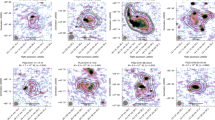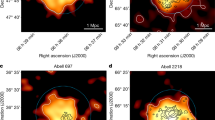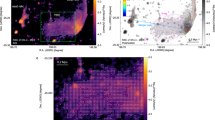Abstract
Clusters of galaxies are the largest gravitationally bound objects in the Universe, containing about 1015 solar masses of hot (108 K) gas, galaxies and dark matter in a typical volume of 10 Mpc3. Magnetic fields and relativistic particles are mixed with the gas as revealed by giant ‘radio haloes’, which arise from diffuse, megaparsec-scale synchrotron radiation at cluster centre1,2. Radio haloes require that the emitting electrons are accelerated in situ (by turbulence)3,4,5,6, or are injected (as secondary particles) by proton collisions into the intergalactic medium7,8,9,10. They are found only in a fraction of massive clusters that have complex dynamics11,12,13,14, which suggests a connection between these mechanisms and cluster mergers. Here we report a radio halo at low frequencies associated with the merging cluster Abell 521. This halo has an extremely steep radio spectrum, which implies a high frequency cut-off; this makes the halo difficult to detect with observations at 1.4 GHz (the frequency at which all other known radio haloes have been best studied). The spectrum of the halo is inconsistent with a secondary origin of the relativistic electrons, but instead supports turbulent acceleration, which suggests that many radio haloes in the Universe should emit mainly at low frequencies.
This is a preview of subscription content, access via your institution
Access options
Subscribe to this journal
Receive 51 print issues and online access
$199.00 per year
only $3.90 per issue
Buy this article
- Purchase on Springer Link
- Instant access to full article PDF
Prices may be subject to local taxes which are calculated during checkout



Similar content being viewed by others
References
Giovannini, G. & Feretti, L. in Diffuse Radio Sources and Cluster Mergers: Radio Haloes and Relics (eds Feretti, L., Gioia, I. M. & Giovannini, G.) 197–227 (Astrophys. Space Sci. Library 272, Kluwer, 2002)
Ferrari, C., Govoni, F., Schindler, S., Bykov, A. M. & Rephaeli, Y. Observations of extended radio emission in clusters. Space Sci. Rev. 134, 93–118 (2008)
Jaffe, W. J. Origin and transport of electrons in the halo radio source in the Coma cluster. Astrophys. J. 212, 1–7 (1977)
Schlickeiser, R., Sievers, A. & Thiemann, H. The diffuse radio emission from the Coma cluster. Astron. Astrophys. 182, 21–35 (1987)
Brunetti, G., Setti, G., Feretti, L. & Giovannini, G. Particle reacceleration in the Coma cluster: radio properties and hard X-ray emission. Mon. Not. R. Astron. Soc. 320, 365–378 (2001)
Petrosian, V. On the nonthermal emission and acceleration of electrons in coma and other clusters of galaxies. Astrophys. J. 557, 560–572 (2001)
Dennison, B. Formation of radio halos in clusters of galaxies from cosmic-ray protons. Astrophys. J. 239, L93–L96 (1980)
Blasi, P. & Colafrancesco, S. Cosmic rays, radio halos and nonthermal X-ray emission in clusters of galaxies. Astropart. Phys. 12, 169–183 (1999)
Dolag, K. & Ensslin, T. A. Radio halos of galaxy clusters from hadronic secondary electron injection in realistic magnetic field configurations. Astron. Astrophys. 362, 151–157 (2000)
Pfrommer, C. & Ensslin, T. A. Estimating galaxy cluster magnetic fields by the classical and hadronic minimum energy criterion. Mon. Not. R. Astron. Soc. 352, 76–90 (2004)
Giovannini, G., Tordi, M. & Feretti, L. Radio halo and relic candidates from the NRAO VLA Sky Survey. New Astron. 4, 141–155 (1999)
Buote, D. A. On the origin of radio halos in galaxy clusters. Astrophys. J. 553, L15–L18 (2001)
Cassano, R. et al. Revised statistics of radio halos and the reacceleration model. Astron. Astrophys. 480, 687–697 (2008)
Venturi, T. et al. GMRT Radio Halo Survey in galaxy clusters at z = 0.2 - 0.4. II.The eBCS clusters and analysis of the complete sample. Astron. Astrophys. 484, 327–340 (2008)
Fujita, Y., Takizawa, M. & Sarazin, C. L. Nonthermal emissions from particles accelerated by turbulence in clusters of galaxies. Astrophys. J. 584, 190–202 (2003)
Kuo, P.-H., Hwang, C.-Y. & Ip, W.-H. Diagnostic signatures of radio and hard X-ray emission on particle acceleration processes in the Coma cluster. Astrophys. J. 594, 732–740 (2003)
Brunetti, G., Blasi, P., Cassano, R. & Gabici, S. Alfvenic reacceleration of relativistic particles in galaxy clusters: MHD waves, leptons and hadrons. Mon. Not. R. Astron. Soc. 350, 1174–1194 (2004)
Melrose, D. B. Plasma Astrophysics (Gordon & Breach, 1980)
Cassano, R. & Brunetti, G. Cluster mergers and non-thermal phenomena: a statistical magnetoturbulent model. Mon. Not. R. Astron. Soc. 357, 1313–1329 (2005)
Brunetti, G. & Lazarian, A. Compressible turbulence in galaxy clusters: physics and stochastic particle re-acceleration. Mon. Not. R. Astron. Soc. 378, 245–275 (2007)
Brunetti, G. et al. Cosmic rays and radio halos in galaxy clusters: New constraints from radio observations. Astrophys. J. 670, L5–L8 (2007)
Arnaud, M., Maurogordato, S., Slezak, E. & Rho, J. A521: A cluster forming at the crossing of two filaments? Astron. Astrophys. 355, 461–478 (2000)
Ferrari, C., Arnaud, M., Ettori, S., Maurogordato, S. & Rho, J. Chandra observation of the multiple merger cluster Abell 521. Astron. Astrophys. 446, 417–428 (2006)
Giacintucci, S. et al. Shock acceleration as origin of the radio relic in A521? Astron. Astrophys. 486, 347–358 (2008)
Cohen, A. S. et al. The VLA Low-Frequency Sky Survey. Astron. J. 134, 1245–1262 (2007)
Sarazin, C. L. The energy spectrum of primary cosmic-ray electrons in clusters of galaxies and inverse Compton emission. Astrophys. J. 520, 529–547 (1999)
Brunetti, G. & Blasi, P. Alfvenic reacceleration of relativistic particles in galaxy clusters in the presence of secondary electrons and positrons. Mon. Not. R. Astron. Soc. 363, 1173–1187 (2005)
Reimer, O., Pohl, M., Sreekumar, P. & Mattox, J. R. EGRET upper limits on the high-energy gamma-ray emission of galaxy clusters. Astrophys. J. 588, 155–164 (2003)
Pfrommer, C. & Ensslin, T. A. Constraining the population of cosmic ray protons in cooling flow clusters with γ-ray and radio observations: Are radio mini-halos of hadronic origin? Astron. Astrophys. 413, 17–36 (2004)
Cassano, R., Brunetti, G. & Setti, G. Statistics of giant radio haloes from electron reacceleration models. Mon. Not. R. Astron. Soc. 369, 1577–1595 (2006)
Acknowledgements
We acknowledge partial support from ASI-INAF I/088/06/0 and PRIN-INAF 2007. G.B. and R.C. acknowledge the Harvard-Smithsonian Center for Astrophysics, the US Naval Research Laboratory and the National Radio Astronomy Observatory for hospitality and partial support during the preparation of the manuscript. Basic research in radio astronomy at the Naval Research Laboratory is supported by 6.1 base funding. The National Radio Astronomy Observatory is operated by Associated Universities, Inc., under cooperative agreement with the National Science Foundation. We thank R. Athreya and the staff of the GMRT for their helping during the observations. The GMRT is run by the National Centre for Radio Astrophysics, Tata Institute of Fundamental Research.
Author information
Authors and Affiliations
Corresponding author
Supplementary information
Supplementary Information
This file contains a Supplementary Discussion with Supplementary Figure S1 and Supplementary References. (PDF 736 kb)
Rights and permissions
About this article
Cite this article
Brunetti, G., Giacintucci, S., Cassano, R. et al. A low-frequency radio halo associated with a cluster of galaxies. Nature 455, 944–947 (2008). https://doi.org/10.1038/nature07379
Received:
Accepted:
Issue Date:
DOI: https://doi.org/10.1038/nature07379
This article is cited by
-
Cosmic ray feedback in galaxies and galaxy clusters
The Astronomy and Astrophysics Review (2023)
-
Galaxy clusters enveloped by vast volumes of relativistic electrons
Nature (2022)
-
Diffuse Radio Emission from Galaxy Clusters
Space Science Reviews (2019)
-
The peculiar cluster MACS J0417.5-1154 in the C and X-bands
Astrophysics and Space Science (2018)
-
Clusters of Galaxies and the Cosmic Web with Square Kilometre Array
Journal of Astrophysics and Astronomy (2016)
Comments
By submitting a comment you agree to abide by our Terms and Community Guidelines. If you find something abusive or that does not comply with our terms or guidelines please flag it as inappropriate.



